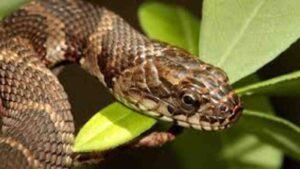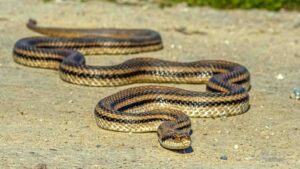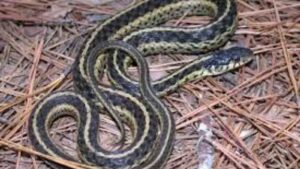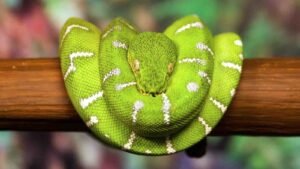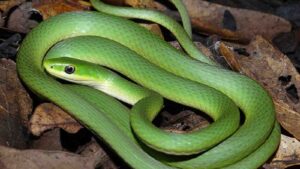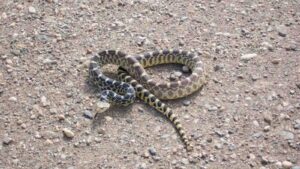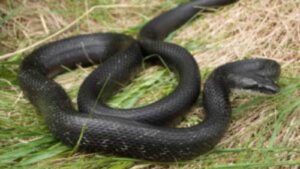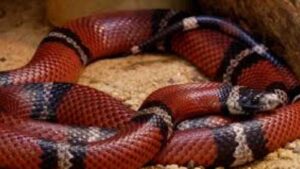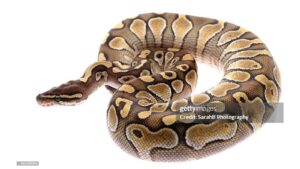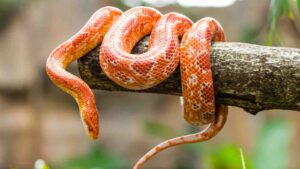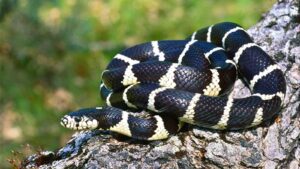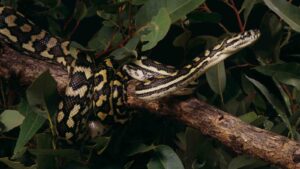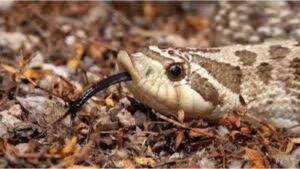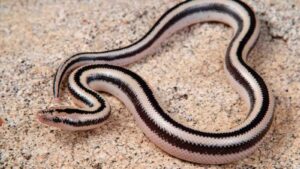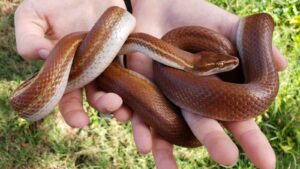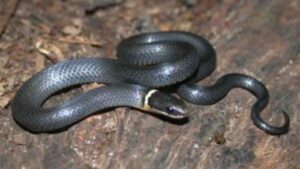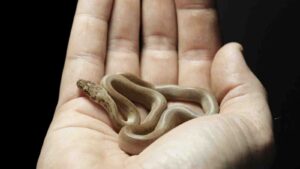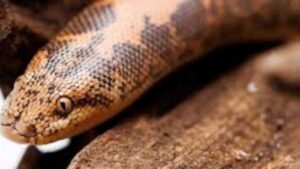Terrifying Snakes That Are Actually Friendly
Summary
Top 20 Terrifying Snakes That Are Actually Friendly. For most of us, one of the most dangerous species on earth is snakes. In spite of being elongated and legless, snakes make up a significant proportion of the middle-order predators that […]

Top 20 Terrifying Snakes That Are Actually Friendly. For most of us, one of the most dangerous species on earth is snakes. In spite of being elongated and legless, snakes make up a significant proportion of the middle-order predators that keep our natural ecosystems working. These deadly-looking animals are actually friendly and harmless; to some extent, they are brilliant pets as well. Here we will show you the top 20 terrifying snakes that are actually friendly.
Video: Terrifying Snakes That Are Actually Friendly
Northern Water Snake
These harmless snakes are found in the Northeastern United States. It is a non-venomous snake that inhabits rivers, ponds, marshes, lakes, and bogs. They appear in either brownish or grayish. Northern water snakes can be mistaken for venomous snakes like water moccasins or rattlesnakes. So, people sometimes kill them on sight.
If you disturb a northern water snake, it would definitely bite you. Because they are very aggressive. But you won’t get in trouble as these snakes’ possess no venom. The bite is just the defensive method. Northern water snakes also release a foul smell and regurgitate their meal to defend the predators.
During the spring and fall, they become very social and find themselves in groups to bask in the sunlight. Northern water snakes mainly feed on insects, fish, mice, and turtles.
Four-lined Snake
They are the largest non-venomous and completely harmless species of rat snakes in Europe. They are named after four dark stripes on their yellowish-brown body. The adult snake reaches up to a length of 1.8 meters. This dangerous-looking snake that is harmless is present in Italy, Slovenia, and Greece. They feed on mice, lizards, and rats.
Video: Terrifying Snakes That Are Actually Friendly
Eastern Garter Snake
Eastern garter snakes are endemic to North America, found in grassy habitats. Eastern garter snakes are harmless to humans. They strike on disturbance, and it makes allergic reactions in humans. They also release a foul smell from its gland to escape from the predators.
The adult Eastern garter snakes have a length of up to 26 inches. They appear in dark green to black color with three yellow stripes. Eastern garter snakes are often confused with queen snakes because they have two yellowish stripes on their back.
Emerald Tree Boa
Emerald tree boas are green tree python-lookalike non-venomous snakes. They live in the rain forests of South America. Emerald tree boas appear in light green color with white irregular zigzag stripes. They are also known as green tree boas and emerald boas.
Emerald tree boas have a length between 1.5 and 2 meters. They also have larger front teeth than any other non-venomous snakes in the world. Emerald boas are tree-dwelling snakes. The powerful body and prehensile tail help them to move from branches to branches. The diet of emerald boa consists of amphibians, small mammals, birds, and small reptiles.
Rough Green Snake
Rough green snake or grass green snake is a non-venomous snake found in the Southeastern United States. They inhabit open forests and woodlands. As the name indicates, grass-green snakes have a bright green upper part and a yellowish belly. This coloration allows them to possess great camouflage in green vegetation.
Rough green snakes have a very thin, long body and reach up to an average length of 45 inches. They spend most of their time on trees and low bushes searching for food. Rough green snakes mainly eat cricketers, grasshoppers, small frogs, and spiders.
Bull Snake
Bullsnake is a large non-venomous snake found in Southwestern Canada, Western Mexico, and the Southern United States. They are also called ‘gopher snakes’ in the U.S. Bull snakes would readily strike when they get disturbed. But they are not harmful because they have no venom. They also vibrate their tails and hiss loudly on the approach of predators.
Bull snakes have a length between 40 and 72 inches. They have a creamy or yellowish-brown body with dark blotches. Bull snakes inhabit pine barren and open country. Bull snakes are farmer-friendly snakes because they eat plenty of crop-destroying rodents.
Black Rat Snake
The black rat snake is one of the common snakes found in North America. They are non-venomous and very large in size and have an average length between 4 and 6 feet. They found in rocky and wooded hillsides, open fields, and mountain ledges. When startled, black snakes become very aggressive. They vibrate their tails in dead leaves to mimic a venomous rattlesnake. They also possess a threatening posture by wrinkle themselves into a series of twists.
Like bull snakes, black rat snakes are also economically beneficial snakes because they feed on crop-damaging rodents. In that way, farmers can also reduce the usage of chemical poisons that affect the environment. The diet list of black rat snakes also includes rabbits, small birds, and lizards.
Milk Snake
Milk snakes are one of the most colorful snakes in the world. They have dark blotches and lighter stripes on the body. The blotches of their body are in black, and the light stripes vary from red, orange-yellow, or white. Milk snakes are non-venomous snakes. The color pattern of milk snakes has great resemblance with venomous coral snakes. It is difficult to tell the difference between a coral snake and a milk snake.
The venomous coral snakes have a red, yellow, and black-yellow color pattern and a blackhead. The harmless milk snakes have a black, red, black, yellow pattern and a redhead. Milk snakes inhabit rocky slopes and forested regions of the U.S. and Central America. They mainly eat slugs, earthworms, crickets, and insects.
Royal Pythons
Royal Pythons are a massive part of the snake world that is widely available. They are a great starter snake for keepers that would prefer a heavy-bodied snake. These snakes generally have a great temperament and are fairly easy to care for. Though they can occasionally be finicky with their food, keeping them in the correct setup usually prevents this. Royal Pythons come in a range of colors and pattern morphs, meaning there is a pattern-color combo to suit all tastes.
Corn Snakes
Corn snakes are also big in the pet trade, mainly due to their great temperament and curious nature. They are the ultimate starter snake for anyone joining the hobby, as they rarely miss a meal and are really easy to look after. Corn snakes can grow to 6 feet but always remain thin-bodied, making them a good choice for people who aren’t as fond of the heavy-bodied snakes. Over the years, breeders have proven out hundreds of different color and pattern morphs, from black to blood red and everything in between.
California Kingsnakes
King snakes are a great choice for keepers who like their pets slightly feistier and make a great pet snake for those who have some experience. California Kingsnakes are the corn snake alternative for thrill-seekers. They grow 5–6 feet and stay fairly light-bodied. With their amazing feeding response, you never have to worry about your snake not eating. Though they are slightly more aggressive by nature, once out of their enclosure, they can be as tame as a corn snake and make brilliant pet snakes. Many king snakes will calm down the longer you have them and can be just as tame as any other snake; they just make you work for it.
Read More: Scariest Animals on Earth that are completely harmless
Carpet Pythons
Carpet pythons are on these lists; first look at arboreal snake species; they tend to belong and are slender with handsome-looking faces. Carpet pythons will spend quite a lot of time up in the mid-to-top parts of their vivarium, making them a great pet for display. When they are younger, they can be quite snappy, but as they grow up, they can make great handlers of pets too. Many keepers take on carpets as a challenge and enjoy their initial temperament. Depending on the species you get, they can range from 7 to 12 feet or more and have a number of natural colors and patterns.
Western Hognose Snakes
Western Hognose snakes are most famous for their upturned noses used for burrowing in the wild, but they actually have some very interesting aspects that you do not see in other similar snakes. Not only are hognose quite small compared to other snakes, maxing out at 4-5 feet, they are also rear-fanged and spend a considerable amount of time burrowing. They are one of the most passive snakes and are very unlikely to bite anything that isn’t food; however, they are also one of the most vocal. When feeling threatened, these snakes puff up and spread their necks like a cobra’s hood; they hiss quite loudly and imitate a defensive position. This is all a complete bluff, though. If they strike, they will tend not to open their mouth and usually bounce off things. Their main defense is to run away, and if that doesn’t work, they roll over and try to play dead.
Rosy Boas
Unfortunately, rosy boas are not as commonly seen in pet stores as corn snakes or ball pythons are. Nevertheless, they make very good pets, especially for beginners. Rosy boas are very attractive, and they are generally undemanding captives. Most are quite tame and don’t present problems at feeding time once they’ve begun taking food regularly. They are another adorable, harmless snake.
Garter Snakes
Garter snakes are familiar to almost everyone who’s spent time outdoors in North America, and it turns out that they often make good pets too. There are a number of garter snake species on the market, but most are relatively similar. They primarily differ in terms of color pattern and food habits. Common garter snakes, for example, will typically live on a fish-based diet, while others prefer to eat worms.
House Snakes
House snakes are interesting snakes from Africa who make fantastic pets. House snakes usually don’t bear bold colors or patterns, but they have very mild, easy-going temperaments and are usually very easy to feed. Additionally, if you’d like to try breeding snakes, house snakes are one of the best choices for beginners.
Ring-neck snakes
Ring-neck snakes are very small snakes, who are generally brown to black, with a yellow to red belly and matching ring around their neck. They typically feed on elongate ectotherms, which means keepers can usually feed them an earthworm-based diet. Ring-neck snakes do have a mild venom, but only the largest individuals can effectively bite humans.
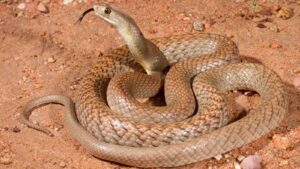
©biomedicalsciences.unimelb.edu
Brown Snakes
Brown snakes are very commonly encountered around human habitation, so it shouldn’t be surprising that they also make good pets. Small and mild-mannered, brown snakes are usually a great choice for beginners, and they can subsist on a diet of earthworms, snails, and slugs. It may, however, be difficult to find captive-bred individuals on the market.
Childrens Pythons
The Children’s Python is a small Australian species that is sometimes kept as a pet. Children’s pythons are normally rather tame, although young individuals may be nippy. Young children’s pythons can be difficult to feed, so beginners should try to acquire a juvenile or adult specimen to avoid these problems. They might look scary, but not harmful at all!
Sand Boas
Sand boas are small boas who are much easier to maintain than some of their larger cousins are. Most sand boas are relatively tame, and they are typically easy to feed. Some species are quite colorful and attractive, but they do spend most of their time buried beneath the substrate. There are several species of sand boa on the market, but Kenyan sand boas are the most readily available.
Do you want a snake as a pet? Let us know in the comment section.
Read More: Scariest Monster People Actually Won
Top,Best,education,top 10,list,top 5,snakes,most dangerous snakes in the world,most venomous snakes,most poisonous snakes,deadliest snakes,black mamba,anaconda,king cobra,inland taipan,tiger snake, sea snake,rattlesnake,brown snake,death adder,Philippine cobra,Australia,snake attacks,diamondback rattler,Amazon jungle,kiss of death,Africa,venom,top ten,best,worst,venomous snakes representative species,fierce snake,actually friendly,actually exist
terrifying snakes that are friendly, actually friendly, snakes, sea snakes, tiger snakes, actually exist, snakes, most dangerous snakes in the world, snake attacks, snake bites, terrifying snakes, venomous snakes, representative species, friendly snakes, fierce snakes, terrifying,top 10 scariest friendly snakes in the world, Brown snake, deadliest snakes, most venomous snakes, most poisonous snakes, pet snake, snake drinking water, deadly snake encounters, friendliest scary snakes, friendliest snakes, snake attack
